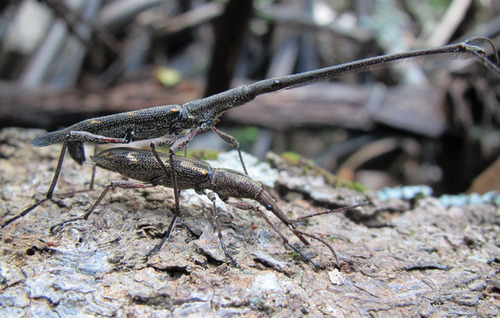#Brentidae
Explore tagged Tumblr posts
Text

inkwash bugs
#bflyart#bug art#tardigrada#myriapoda#amphipoda#arachnida#coleoptera#hymenoptera#diptera#lepidoptera#hemiptera#neuroptera#curculionidae#formicidae#cicindelidae#salticidae#chilopoda#scolopendridae#mantispidae#brentidae#scolytidae#isopoda#ligiidae#scelionidae#baeus#caprellidae#psychidae#psychodidae#chrysomelidae#sphingidae
2K notes
·
View notes
Photo



Spined straight-snouted weevil, Pogonapion kuscheli, Brentidae
Found in New Caledonia
Photos by damienbr
#animals#curators on tumblr#insects#bugs#beetle#weevil#straight snouted weevil#brentidae#spined straight snouted weevil#Pogonapion kuscheli#one nice bug
3K notes
·
View notes
Text


straight snouted weevil (idk species but its cute)
comically fat thorax and then a tiny ass head... i dont have much to say for this post i just like this weevil
ive seen it twice and something about the colours + texture + overall shape of it just makes me like it
if anyone can give me a species ID i would appreciate it
#photography#macro#nature#bugs#arthropods#entomology#weevils#beetle#brentidae#coleoptera#bugblr#insects#invertebrates#bug#weeviladay
58 notes
·
View notes
Text
Uncharismatic Fact of the Day
Aptly named, the New Zealand giraffe weevil is the longest beetle in Aotearoa. Males can reach a length of 90 mm (3.5 in), half of which is their elongated snout. These extraordinary appendages are used to battle for access to females, which have much shorter snouts.

(Image: A mating male (top) and female (bottom) New Zealand giraffe weevil () by Christina Painting)
If you like what I do, consider leaving a tip or buying me a ko-fi!
#new zealand giraffe weevil#Coleoptera#Brentidae#straight snouted weevils#weevils#beetles#insects#arthropods#uncharismatic facts
249 notes
·
View notes
Text

Art af spidsmussnudebille (Apion frumentarium)
Apion frumentarium (Apion frumentarium)
#Apion frumentarium#Apion#Spidsmussnudebille#Snudebille#Weevil#Brentidae#Bille#Beetle#Coleoptera#Insekt#Insect#Have#Garden#summer#sommer
21 notes
·
View notes
Text


[PHOTOS TAKEN: JUNE 28TH, 2024 | Image IDs: Two photos of a small brown and yellow Brentid weevil on the corner of a white metal building /End IDs.]
#Brentidae#curculionidae#weevil#weevils#Beetles#Beetle#Coleoptera#insect#insects#entomology#bug#bugs#Bugblr#invertebrates#inverts#arthropods#Wasp House Sights#photos#photo
5 notes
·
View notes
Text
youtube
The New Zealand giraffe beetle, Lasiorhynchus barbicornis, is a straight-snouted weevil in the subfamily Brentinae, endemic to New Zealand.
1 note
·
View note
Text
244 notes
·
View notes
Text
Parution d'un ouvrage sur l'Apion du trèfle en France
See on Scoop.it - Variétés entomologiques
Après trois années de travail sur le sujet, nous sommes très heureux de vous faire part de la sortie de l’ouvrage de synthèse traitant de l’Apion du trèfle en France.
Vient de paraître !
Référence : Fabre H., Chapelin-Viscardi J.-D., Loiseau S., Couturier-Boiton F. & Coussy B., 2023. –
L’Apion du trèfle Protapion trifolii en France (Coleoptera Brentidae Apioninae). Supplément au tome 79, L’Entomologiste, 64 p.
0 notes
Text

its time to think about critters
#bflyart#bug doodles#hermit crab#passalidae#brentidae#scarabaeidae#hymenopodidae#sesiidae#grub#did u know you can give me $5 to draw any bug or bug type animal
1K notes
·
View notes
Photo

Bug of the Day
An oak timberworm (Arrhenodes minutus) from last June. I love these little guys!
79 notes
·
View notes
Photo


Hose-nosed Weevil Antliarhis zamiae
“The specimen in the photograph is a female, with the very long rostrum. The males have a much shorter rostrum. The females of this species are the record-holders world-wide for the weevils with the longest snout as compared to the length of the body.
The female uses here extremely long snout to bore a canal through the wall of a cycad seed, which has an internal cavity. She then extracts the snout from the canal, turns around, and extrudes an equally remarkably long ovipositor through the hole she has bored. Eggs are then laid in the central cavity of the cycad seed, where the larvae develop.” x
Source
2K notes
·
View notes
Photo

Hairy flea leg weevil (Catagogus diorymerus)
Photo by Steve & Alison1
#hairy flea leg weevil#catagogus diorymerus#catagogus#cyphagogini#cyphagoginae#brentidae#curculionoidea#cucujiformia#polyphaga#coleoptera#coleopterida#endopterygota#neoptera#pterygota#insecta#hexapoda#pancrustacea#arthropoda#panarthropoda#ecdysozoa
15 notes
·
View notes
Video
tumblr
handful of l o n g b o y s
#coleoptera#brentidae#weevils#pets#i got some dead specimens but never considered having a live colony#but now thats all i'm considering
2K notes
·
View notes


